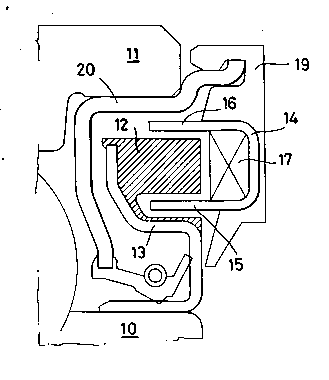Une partie des informations de ce site Web a été fournie par des sources externes. Le gouvernement du Canada n'assume aucune responsabilité concernant la précision, l'actualité ou la fiabilité des informations fournies par les sources externes. Les utilisateurs qui désirent employer cette information devraient consulter directement la source des informations. Le contenu fourni par les sources externes n'est pas assujetti aux exigences sur les langues officielles, la protection des renseignements personnels et l'accessibilité.
L'apparition de différences dans le texte et l'image des Revendications et de l'Abrégé dépend du moment auquel le document est publié. Les textes des Revendications et de l'Abrégé sont affichés :
| (12) Brevet: | (11) CA 2014049 |
|---|---|
| (54) Titre français: | DISPOSITIF DE MESURE DE LA VITESSE DE ROTATION RELATIVE DE DEUX PIECES TOURNANTES, TELS DES SUPPORTS DE ROUE DE VEHICULE |
| (54) Titre anglais: | DEVICE ENABLING THE REVOLUTIONARY SPEED TO BE MEASURED BETWEEN TWO PARTS IN RELATIVE ROTATION SUCH AS THE SUPPORTS OF A VEHICLE WHEEL |
| Statut: | Périmé et au-delà du délai pour l’annulation |
| (51) Classification internationale des brevets (CIB): |
|
|---|---|
| (72) Inventeurs : |
|
| (73) Titulaires : |
|
| (71) Demandeurs : |
|
| (74) Agent: | MARKS & CLERK |
| (74) Co-agent: | |
| (45) Délivré: | 1996-01-30 |
| (22) Date de dépôt: | 1990-04-06 |
| (41) Mise à la disponibilité du public: | 1991-06-15 |
| Requête d'examen: | 1992-03-24 |
| Licence disponible: | S.O. |
| Cédé au domaine public: | S.O. |
| (25) Langue des documents déposés: | Anglais |
| Traité de coopération en matière de brevets (PCT): | Non |
|---|
| (30) Données de priorité de la demande: | ||||||
|---|---|---|---|---|---|---|
|
Device enabling the speed to be measured between two
parts in relative rotation such as the supports of a vehicle
wheel and in particular between rings of a rolling bearing
for the support of a vehicle wheel, characterized by the
fact that a first shield integral with the rotating ring of
the bearing carries a magnetized ring with pairs of
alternate poles, which is placed in front of, in operation, a
passive sensor borne by a second shield attached to the
fixed ring of the bearing; the sensor being inductive with n
pole pieces in a number proportional to the pairs of
alternate poles of the magnetized ring; the configurations
of shields and sensor being such that the elements measuring
the relative speed are integral with the shields and protec-
ted outwards.
Note : Les revendications sont présentées dans la langue officielle dans laquelle elles ont été soumises.
Note : Les descriptions sont présentées dans la langue officielle dans laquelle elles ont été soumises.

2024-08-01 : Dans le cadre de la transition vers les Brevets de nouvelle génération (BNG), la base de données sur les brevets canadiens (BDBC) contient désormais un Historique d'événement plus détaillé, qui reproduit le Journal des événements de notre nouvelle solution interne.
Veuillez noter que les événements débutant par « Inactive : » se réfèrent à des événements qui ne sont plus utilisés dans notre nouvelle solution interne.
Pour une meilleure compréhension de l'état de la demande ou brevet qui figure sur cette page, la rubrique Mise en garde , et les descriptions de Brevet , Historique d'événement , Taxes périodiques et Historique des paiements devraient être consultées.
| Description | Date |
|---|---|
| Le délai pour l'annulation est expiré | 2006-04-06 |
| Inactive : CIB de MCD | 2006-03-11 |
| Inactive : CIB de MCD | 2006-03-11 |
| Lettre envoyée | 2005-04-06 |
| Accordé par délivrance | 1996-01-30 |
| Exigences pour une requête d'examen - jugée conforme | 1992-03-24 |
| Toutes les exigences pour l'examen - jugée conforme | 1992-03-24 |
| Demande publiée (accessible au public) | 1991-06-15 |
Il n'y a pas d'historique d'abandonnement
| Type de taxes | Anniversaire | Échéance | Date payée |
|---|---|---|---|
| TM (brevet, 8e anniv.) - générale | 1998-04-06 | 1998-03-18 | |
| TM (brevet, 9e anniv.) - générale | 1999-04-06 | 1999-03-24 | |
| TM (brevet, 10e anniv.) - générale | 2000-04-06 | 2000-03-20 | |
| TM (brevet, 11e anniv.) - générale | 2001-04-06 | 2001-03-21 | |
| TM (brevet, 12e anniv.) - générale | 2002-04-08 | 2002-03-20 | |
| TM (brevet, 13e anniv.) - générale | 2003-04-07 | 2003-03-20 | |
| TM (brevet, 14e anniv.) - générale | 2004-04-06 | 2004-03-22 |
Les titulaires actuels et antérieures au dossier sont affichés en ordre alphabétique.
| Titulaires actuels au dossier |
|---|
| SKF INDUSTRIE S.P.A. |
| Titulaires antérieures au dossier |
|---|
| ANGELO VARVELLO |
| ANGELO VIGNOTTO |
| ROBERTO MORETTI |